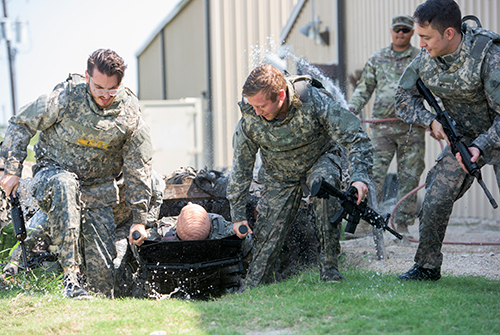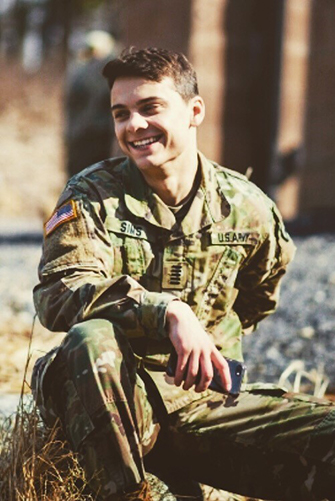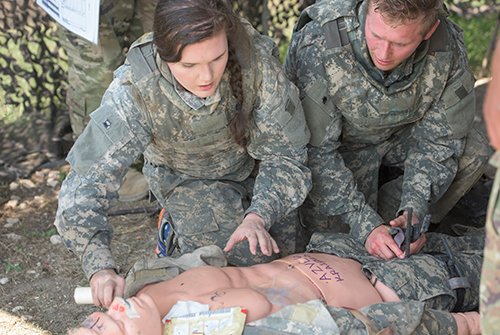 The U.S. military is facing increasing shortages in key medical personnel, particularly in the critical go-to-war specialties—orthopedic surgery, general surgery and neurosurgery—as well as programs like family practice and emergency medicine. Texas A&M is working to solve that problem.
The U.S. military is facing increasing shortages in key medical personnel, particularly in the critical go-to-war specialties—orthopedic surgery, general surgery and neurosurgery—as well as programs like family practice and emergency medicine. Texas A&M is working to solve that problem.
Kenneth Sims is committed to a life of challenges and service.
He found the perfect combination at the U.S. Military Academy West Point. Sims, who graduates this May, loves the academy’s rigorous academic standards, the demanding physical and military training, the intense leadership development and the commitment to the nation.
Now, his sights are focused on a new challenge—earning a medical degree from Texas A&M University’s College of Medicine. Sims is one of the first students to enroll in the college’s Military to Medicine program, which is part of the Texas A&M Health Science Center’s military health priority. Sims is also among 25 students selected for the inaugural Engineering Medicine (EnMed) track.
This priority, which aligns with the university’s military legacy and creates opportunities for future and current service members, will help service members and veterans adapt to changes in military medicine practices.
For example, policymakers recently set a new course of action that will deploy more medical staff as part of military units. In addition, fewer medical professionals will be assigned to military treatment facilities. “There’s going to be a huge shift in the types of physicians who will be needed in military medicine and the potential impact on the military treatment facilities and how they’re run,” said Maj. Gen. Brian Lein, former commander of the U.S. Army Medical Department Center and School and the U.S. Army Medical Research and Materiel Command. “This will be a significant change in how military health care has done business in the last five to 10 years.”
The military is also facing increasing shortages in key medical personnel. “There’s a shortage in the critical go-to-war specialties—orthopedic surgery, general surgery and neurosurgery—as well as programs like family practice and emergency medicine. We don’t have near enough medical personnel within our forces,” said Lein, who serves on the college’s military advisory board. “With these changes and Texas A&M’s ability to help out in this area, there’s a greater opportunity to leverage a partnership.”
Here are four ways the College of Medicine is answering the call for more military physicians.
No. 1: By creating the Department of Military Medicine
The College of Medicine was created 42 years ago in conjunction with the Central Texas Veterans Health Care System to serve veterans. In the mid-2000s, college officials initially connected to the military to recruit veterans to apply to the medical school and to encourage prospective students to consider pursuing military medicine.
 Kenneth Sims is one of the first students to enroll in the college’s Military to Medicine program, which is part of the Texas A&M Health Science Center’s military health priority.
Kenneth Sims is one of the first students to enroll in the college’s Military to Medicine program, which is part of the Texas A&M Health Science Center’s military health priority.
In 2017, the college expanded its commitment by creating the Department of Military Medicine. This program is designed to train students to provide medical care for the armed forces, their families and veterans as well as advance care through research.
While a national search for a department chair is currently underway, the college has already made other significant strides. For example, Dr. Israel Liberzon, an expert in post-traumatic stress disorder (PTSD), joined the college as department head of psychiatry.
As part of this effort, the college also plans to expand its partnerships with military facilities so that students can experience military medicine firsthand. For example, it has a long-standing relationship with Fort Hood’s Carl R. Darnall Army Medical Center. Similar partnerships have been created with Lackland Air Force Base’s 59th Medical Wing and Wilford Hall Medical Facility. Through these arrangements, medical students can take senior electives and do third-year clerkships.
These partnerships enable students to get experience in military treatment facilities that focus on areas such as emergency medicine and prosthetics. Additionally, Texas A&M medical students can take electives at Fort Sam Houston’s Brooke Army Medical Center and the San Antonio Medical Center. “These connections give our military-bound medical students a chance to do rotations at these facilities,” said Filomeno Maldonado, the College of Medicine’s associate dean of admissions. “They get a rich experience that is quite unique from public and private medicine simply because of the populations that are being served, which include veterans as well as active-duty personnel who are returning from Afghanistan, Iraq or other hotspots in the world.”
The Health Science Center is also working with the Department of Defense, Defense Advanced Research Projects Agency and the Department of Veteran Affairs to conduct military medical research.
No. 2: By involving active military members in Health Science Center events
The Health Science Center has begun including active service members in some of its interprofessional student activities. For instance, its annual Disaster Day, which is the largest student-led disaster simulation in the nation, lets first responders practice key skills that they will need during a crisis.
With the oversight of National Guard units, Corps of Cadets members learn to extract individuals from rubble, get injured people to a triage center and organize traffic flow. Their presence also makes this disaster simulation more realistic for the health professions students.
Interprofessional teams of Health Science Center students are also involved with military first responders when they participate in Operation Lone Star, which tests the state’s capacity to respond to an emergency. As part of this exercise, underserved populations in six South Texas cities receive free wellness checks and health care.
The college is further working with the military to offer events such as Suture Clinics, which are designed as outreach for prospective students in college or high school. Military representatives also recruit at the College of Medicine and provide financial support for several events.
No. 3: By collaborating with the Corps of Cadets
As a new partnership with the Corps of Cadets, the Cadet to Medicine Early Assurance Program gives up to five cadets conditional admittance to the College of Medicine during their sophomore or junior year.
Selected cadets must have a minimum 3.5 GPA, be committed to a career in military medicine and have a desire to serve others. Besides early admittance, this program provides participants with extra support through free MCAT preparation and shadowing experiences with physicians. These students also take part in a Pathway to Medicine seminar course designed to prepare them for medical school.
“We are happy to continue honoring the military legacy at Texas A&M through this pipeline program,” said Brig. Gen. Joe Ramirez ’79, commandant of the Corps. “It is one more opportunity for our cadets to showcase their talents, leadership and dedication to service through a targeted program that will produce more military physicians for our nation.”
 As a new partnership with the Corps of Cadets, the Cadet to Medicine Early Assurance Program gives up to five cadets conditional admittance to the College of Medicine during their sophomore or junior year.
As a new partnership with the Corps of Cadets, the Cadet to Medicine Early Assurance Program gives up to five cadets conditional admittance to the College of Medicine during their sophomore or junior year.
No. 4: By partnering with the U.S. Military Academies
The college is developing a similar early assurance program with the nation’s military academies—West Point, the Naval Academy and the Air Force Academy—and is putting agreements into place to recruit three students from each service academy. Texas A&M representatives now have a regular presence at the academies to discuss the military medicine program as well as the college’s interdisciplinary EnMed (engineering and medicine) program. “We know that these institutions have students on a routine basis who want to pursue a military medicine billet instead of something else,” Maldonado said.
Kenneth Sims’ interest in pursuing a medical career started at the same time he became interested in West Point. “I had the opportunity to intern in a hospital for a semester in high school,” the Lafayette, Louisiana, native said. “That’s where I started to develop a passion for helping people and a mission for service. It hit me that maybe I wanted to do military medicine and become an Army doctor.”
Sims, who earned a mechanical engineering degree from West Point, quickly saw the implications of his studies for medicine. “There’s a lot of applications of mechanical engineering to the human body, medicine, biotechnology and medical devices,” he said. “That’s the first time that my intellectual curiosity was really heightened, seeing where mechanical engineering can intersect with biology and physiology.”
The newly commissioned second lieutenant wanted to find a medical school where he could combine his passions for medicine and mechanical engineering. He eventually attended a Texas A&M College of Medicine informational—and found his next challenge in the EnMed track. “Everything that was described was what I was envisioning as a dream situation—going to a medical school that integrates engineering into medicine,” Sims said. “I didn’t think it existed, but it turns out that Texas A&M is starting that program.”
While many prospective students are interested in serving their country through a medical billet, some see cost as a barrier. Therefore, one of the Health Science Center’s main funding priorities is creating scholarships for students who want to pursue military medicine. Endowed scholarships can be created through a $25,000 gift to the Texas A&M Foundation, payable over a five-year period. To learn more, contact Kirk Joseph '84 below.